
This crop of Spartacus barley at Rand in southern NSW is one of many cereal crops throughout the state which looks to have a 5t/ha yield potential. Photo: John Stevenson
GROWER and trader selling on nearby and new-crop barley has driven values down to levels which are buying bulk and containerised export demand.
The nearby Darling Downs delivered barley market has taken the biggest tumble and dropped $50 per tonne in the past week, with wheat down $40/t, as traders unwind their positions ahead of new-crop coming at them like a train.
Falls have been more moderate in southern markets where successive rains have improved yield prospects to the point where growers feel comfortable about committing some more tonnage from the November-December harvest.
This is being squared away by traders selling to export accumulators or customers, with China on wheat and Thailand on barley said to be in the market for December shipment onward in the past week or two.
Bucking the trend is the sorghum market, which has traded steady to higher based on container demand from China for current crop, and what appears to be accumulation for new-crop bulk exports.
| This week | Last week | Change | |
| Barley Downs Sep | $275 | $315 | Down |
| Barley Downs Jan | $235-$240 | $250 | Down |
| Barley Melbourne Sep | $230 | $245 | Down |
| Barley Melbourne Jan | $225 | $230 | Down |
| Wheat Downs Sep | $350 | $390 | Steady |
| Wheat Downs Jan | $275 | $280 | Down |
| Wheat Melbourne Sep | $315 | $325-$330 | Down |
| Wheat Melbourne Jan | $280 | $275 | Up |
| Sorghum Downs Sep | $320 | $315 | Up |
| Sorghum Downs Mar-Apr | $275 | $270 | Up |
Table 1: Indicative delivered grain prices in AUD per tonne.
Southern confidence grows
While pockets of South Australia, Victoria and Western Australia are in urgent need of more rain to bolster yield prospects, most southern Australia cropping districts have had 5-25 millimetres of rain in the past week.
“There’s a lot more liquidity this week in wheat and barley than there was last week,” one trader in the southern market said.
“We’re at export parity on wheat and barley, there’s container business being written for old and new crop, and we’re seeing bulk business getting done on new crop.
“The inverse on wheat will disappear very soon.”
Sources have said feedgrain consumers in south-eastern Australia have all the cover they want into January, and are now looking at buying at a flat price for January-June delivery.
“Consumers don’t want to be competing against people buying for the first vessels on the new-crop stem.”
Pearsons Grain trader Reagan Stroud said the nearby northern Victorian barley market had lost some of its strength born out of demand from consumers as far north as the Darling Downs.
“A lot of northern Vic grain was finding its way for Aug-Sep delivery to the Downs, but no one wants to take long old-crop positions now.”
The up-country inverse between nearby and new-crop barley positions has shrunk to around $35/t from roughly $70/t at the start of August.
“The trade’s now trying to price for Oct-Nov delivery to stockfeed mills.”
Mr Stroud said recent rain had increased grower confidence in advancing their forward-sales program.
“I don’t think we’re talking bin busters, but it’s put them back in the game.”
Feedlots juggle supply
Broun & Co principal Wal Broun said feedlots were buying from growers for new-crop delivery.
“A lot of the feedlots need to get deliveries in October, and they’re expecting new crop.
“There’s a risk out there that if we have a wet October, that could stall the barley harvest.
“Feedlots are starting to get a little bit of coverage now, and in the past week or two, they’ve been buying from growers.”
Mr Broun said feedlots were weighing up the risk of a rain-delayed harvest against the likelihood of new-crop prices falling further on growing selling.
“The feedlots are still wanting to keep some harvest slots open.”
Tempering feedlot demand for grain is the reduced kill capacity from feedlots, and continuing tight supplies of cattle as pastures and grazing crops like oats offer ample feed.
“The old-crop market’s heading south.
“Barley in the past week in the Riverina has fallen to $20-$30/t over new-crop from $70/t at the start of the month.”
Reports are trickling in of barley crops with reasonable-to-good yield potential being sprayed out now for harvest in early September.
These have mostly been forward sold to feedlots, and will fill the gap before harvest gathers pace later next month.
Sorghum surprises
Southern Queensland has had a patchy 20-30mm in the past week which is building hopes for a big sorghum plant from next month.
Robinson Grain Toowoomba-based trader Anthony Furse said trade in new-crop sorghum, which was expected to hit the market from March, had picked up in the past week, with Chinese demand the likely driver.
“Strong internal corn prices in China are pointing to that feedgrain demand, as well as demand for the baijiu spirit.
“We now have the situation where new-crop sorghum at $280/t track Brisbane is at a premium to wheat, and we’re seeing some grower selling.”
The very small Queensland sorghum crop has been harvested, and is believed to be mostly sold to the container market, and some domestic poultry and piggery feedmills.
“You’d have to think some of that new-crop sorghum will be bulk.”
Queensland chickpeas and wheat will be packed and exported from October onward in considerable volume for the first time in three years post drought.
Mr Furse said this would shorten supply of 20-foot containers available for sorghum, and made bulk booking seem likely.
The Dalby Bio-Refinery remains closed indefinitely, and appears to be out of the market for grain for ethanol production.
